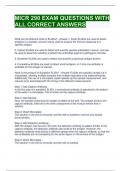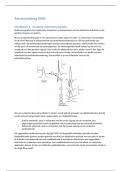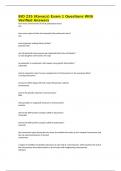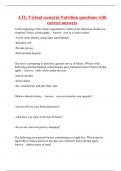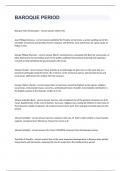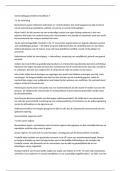ALL CORRECT ANSWERS
What are the different kinds of ELIZAs? - Answer-1. Direct ELISAs are used to detect
antigens in a sample, and are mainly used to analyze the immune response to a
specific antigen.
2. Indirect ELISAs are used to detect and quantify specific antibodies in serum, and can
be used to determine whether a patient has antibodies against a pathogenic microbe.
3. Sandwich ELISAs are used to detect and quantify a particular antigen protein.
4. Competitive ELISAs are used to detect small antigens, or if only one antibody is
available for the antigen of interest.
What is the protocol of Sandwich ELISA? - Answer-ELISAs are typically carried out in
microplates, allowing multiple samples and multiple replicates to be tested efficiently.
Additionally, the use of a microplate reader speeds up the sample measurement, and
reduces error associated with the timing of the different measurements.
Step 1: Add Capture Antibody -
In the first step of a sandwich ELISA, a monoclonal antibody is adsorbed to the bottom
of the wells in a microplate. This is known as the capture antibody.
Step 2: Add Sample -
Next, the sample containing the antigen is added to the well. The antigen binds to the
capture antibody, while all of the other components of the mixture remain free in
solution.
Step 3: Wash Microplate -
The solution in the well is removed, and the well is washed to remove any loosely
bound protein.
Step 4: Add Detection Antibody -
With the antigen now bound in the well, the detection antibody is added. Similar to the
capture antibody, the detection antibody also binds to the antigen. However, the
detection antibody must bind to a different epitope than the capture antibody, so that the
two antibodies are not competing for the same region on the surface of the antigen.
Step 5: Wash Microplate -
The solution in the well is removed, and the well is washed.
,Step 6: Add Secondary Antibody -
An enzyme-linked secondary antibody is added to the well, which binds specifically to
the detection antibody. Often, the enzyme linked to the secondary antibody is
horseradish peroxidase (HRP).
Step 7: Wash Microplate -
The excess secondary antibody is then washed out of the well.
Step 8: Add Substrate -
With the enzyme-linked secondary antibody now bound in the well, a substrate for HRP
is added. Some HRP substrates change colour when they are oxidized by HRP (i.e.
chromogenic substrates), and others emit light when they are oxidized (i.e. che
What is the objective of a sandwhich ELIZA? - Answer-Ultimately, the sandwich ELISA
protocol relates the presence of a specific protein in a sample to a change in colour or
the emission of light. If the sample contains this protein, the detection antibody and the
enzyme-linked secondary antibody will bind in the well, and the enzyme linked to the
secondary antibody forms an observable product in that well. However, if the sample
does not contain this protein, neither the detection antibody or the enzyme-linked
secondary antibody will remain in the well, and there will be no change in colour or
chemiluminescence following the addition of a substrate for the enzyme.
ELISAs vs. Western Blots - Answer-They both:
- Use antibodies to recognize proteins
- Have a readout based on antibody-linked tag or enzyme
How can ELISAs be used to determine the amount of protein in a sample? - Answer-
Similar to the colourimetric protein assays (e.g. Bradford and BCA assays), a calibration
curve mustbe prepared. While the identity of protein used as a standard for Bradford
and BCA assays was not critical, the protein used to prepare a calibration curve for
ELISAs must be the same as the protein that is being qualified due to the specificity of
antibody -antigen interactions. Therefore, ELISAs require a purified sample of the
protein to be qualified. Several dilutions of the protein standard are prepared, and these
dilutions are tested by ELISA in the same manner as the protein sample. Typically, each
dilution is tested in triplicate. Then, the experimental measurements for these standards
(e.g. absorbance) are plotted against the concentration of protein. Based on this
calibration curve, the amount of protein in an unknown sample can be calculated.
Typically, the protein standards are tested at the same time as the unknown sample,
ensuring that experimental error is minimized.
Amino Acids vs. Proteins - Answer-Proteins are long linear chains made of amino acids.
Only alpha-amino acids are used (the amino group is attached to the central/alpha
carbon, and the carboxyl group and side are attached as well + a hydrogen)
,Proteins are composed of 20 amino acids (the can be polar, non-polar etc.)
Amino acids are connected by peptide bonds (bond between the amino group and
carbonyl group) - It is a dehydration reaction that results in a loss of water
What are the protein termini? - Answer-Like DNA, the two ends (termini) of a
polypeptide chain are different.
N-terminus: ends with an amino group
C-terminus: ends with a carboxylic acid group
The sequences are written from N-terminus to C-terminus.
What are 4 structures of proteins? - Answer-1. Primary (linear sequence of amino acids
that make up the protein)
2. Secondary (3D structure of repeating regions - protein backbone folds to create
alpha-helices or beta-sheets - hydrogen bonds help hold them together)
3. Tertiary (3D fold of a single polypeptide chain, includes disulfide linkages and
hydrogen bonds)
4. Quaternary (describes the overall structure of multiple polypeptide chains) ex.
hemoglobin is a tetromer consisting of 4 polypeptides (a1, a2, b1, b2)
What are enzymes? - Answer-Proteins that accelerate chemical reactions. The specific
structure of an enzyme allows it to bind specifically to its substrates (i.e. the molecules
undergoing the chemical reaction), and to convert them into products.
What are the start and stop codons? - Answer-Start: AUG/ATG (methionine)
Stop: UAA/TAA, UAG/TAG, UGA/TGA
Located between the start codon and stop codon are all of the codons that encode for
the amino acids that make up the protein encoded by the gene.
Ratios of codon usage - Answer-The ratio value shows how often a particular codon is
used for a particular amino acid. Some amino acids are encoded by only a single
codon. For example, tryptophan (Trp, W) is only encoded by TGG (or UGG in mRNA),
and so this codon has a ratio of 1.00. However, glutamic acid (Glu, E) can be encoded
by either GAA or GAG. In E. coli, 70% of glutamic acid residues are encoded by GAA
(ratio 0.70), and 30% are encoded by GAG (ratio 0.30). Some codons are very rare in
E. coli. For example, only 5% of arginine (Arg, R) residues are encoded by the codon
CGA (ratio 0.05).
Why might researchers want to know the ratios of codon usage in E.coli genes?
- Each codon is recognized by a specific molecule of tRNA.
- For the codons that are rare, E.coli doesn't produce a lot of tRNA that recognize them.
, - This is a problem during the production of recombinant proteins in E.coli, which may
have many codons that are rare.
- E.coli cells do not have enough tRNA to keep up with protein production (resulting in
low levels of the recombinant protein)
- SOOOO... to overcome this, the genes for recombinant proteins are often codon
optimized (the codon usage is optimal for the organism that is being used to produce
them)
What is the role of tRNA in translation? - Answer-Translates the RNA from mRNA
codons to amino acids.
What is cloning? - Answer-Cloning refers to the process of inserting a sequence of DNA
(also called an insert) into a plasmid. The resulting plasmid is a form of recombinant
DNA, meaning that it is an artificial (i.e. laboratory-produced) construct combining DNA
sequences from two or more different sources.
It refers to the process of inserting a sequence of DNA into a vector. The insert may
come from various sources (e.g. from DNA purified from bacteria), but is most
commonly produced by polymerase chain reaction.
Plasmids used for cloning are known as cloning vectors, and are designed to simplify
the process of transferring an insert into the empty vector. If the goal is to produce a
protein encoded by the insert DNA (i.e. the insert is a gene), a specific kind of cloning
vector known as an expression vector must be used.
What are the correct features of a plasmid? - Answer-Circular, double-stranded DNA
present in the bacterial cytoplasm
Many plasmids carry genes that confer antibiotic resistance
Why are plasmids useful? - Answer-Plasmids are extremely valuable tools for
biotechnology applications, and recombinant plasmids are used in many different areas
of research. By inserting a sequence of DNA into a plasmid and transforming a bacterial
culture with this recombinant DNA, the culture can then be used as a "factory" to
produce a massive number of copies of the plasmid. This is one way to produce copies
of the DNA sequence that was inserted into the plasmid (i.e. the insert). The resulting
plasmid can then be purified from the bacterial culture (e.g. using spin columns) and
used in down-stream applications.
What are vectors? - Answer-The plasmids used in the lab for cloning purposes are
known as vectors, as they act as "vectors" for the insert that they carry.
Many of the plasmids used for research purposes are artificial constructs, combining
DNA sequences from several different sources (including natural bacterial plasmids).

